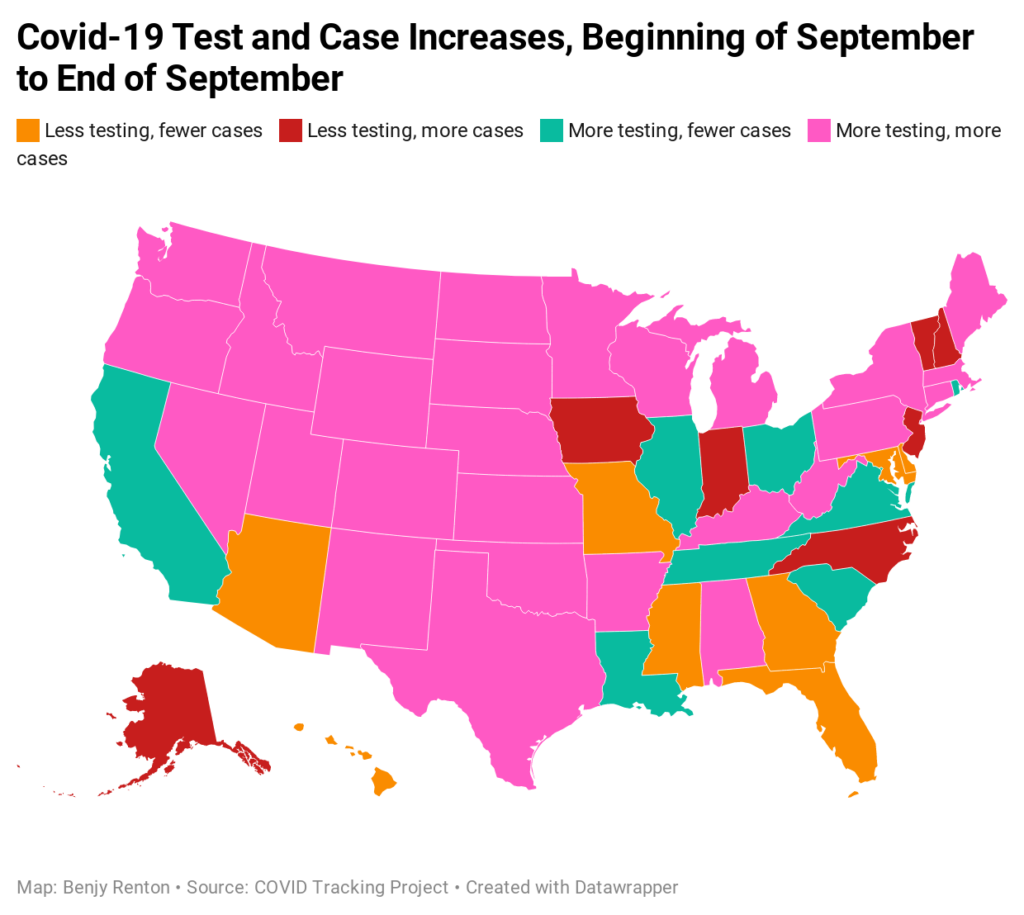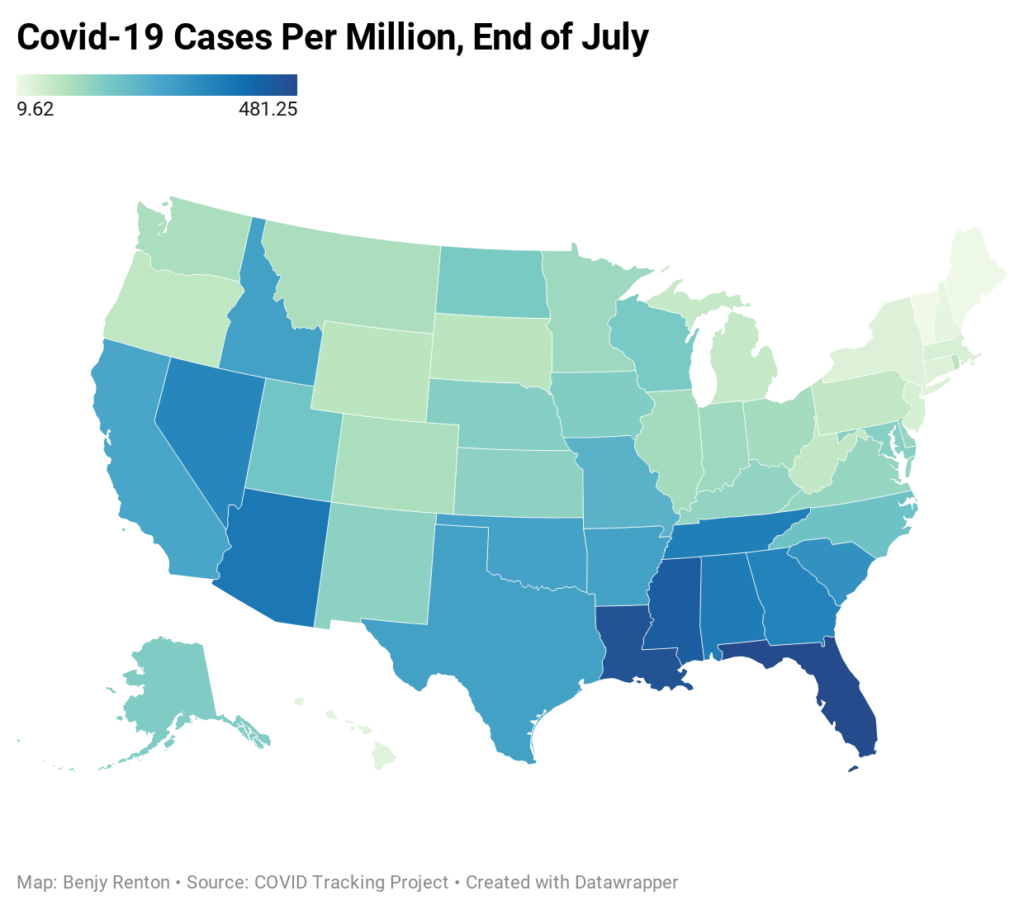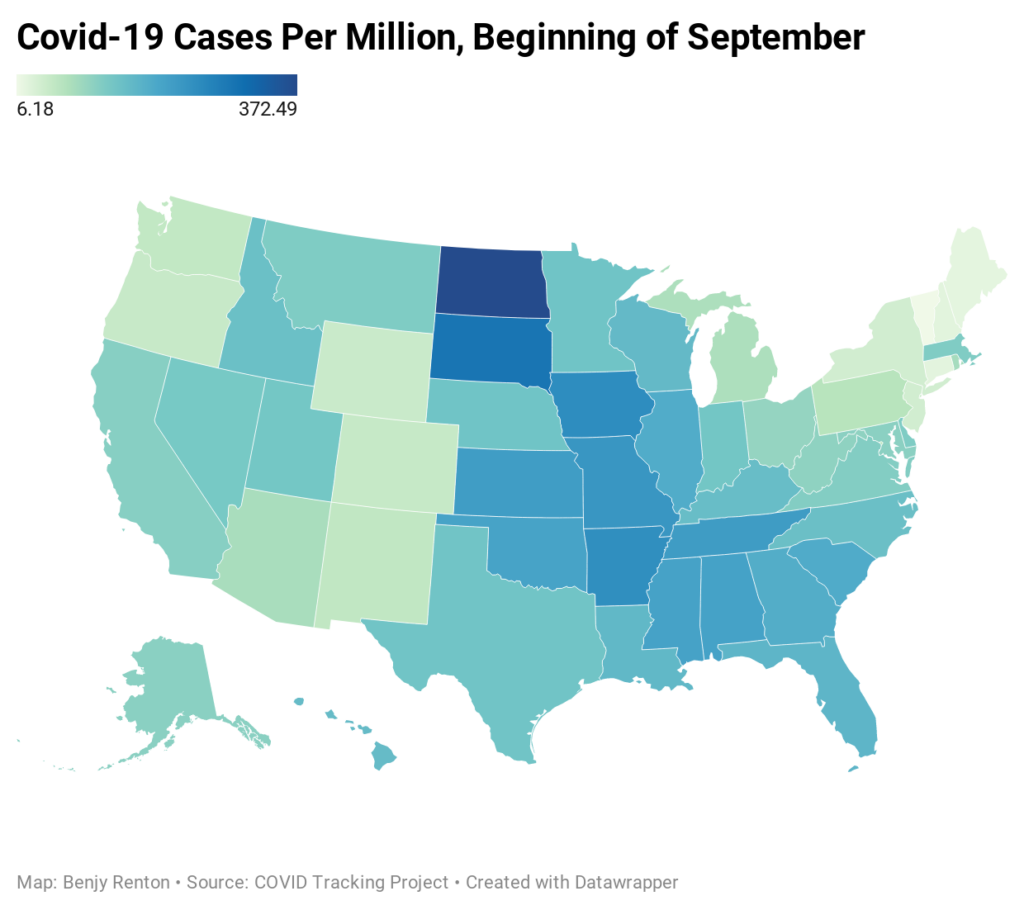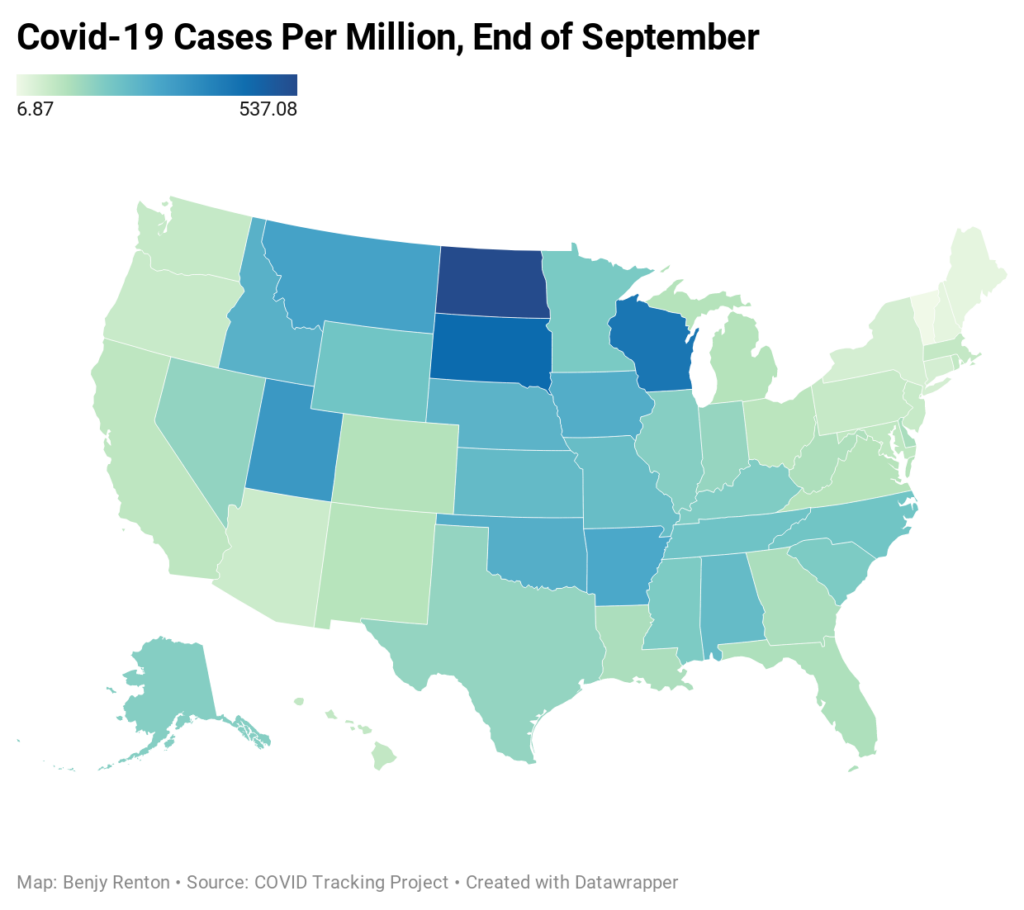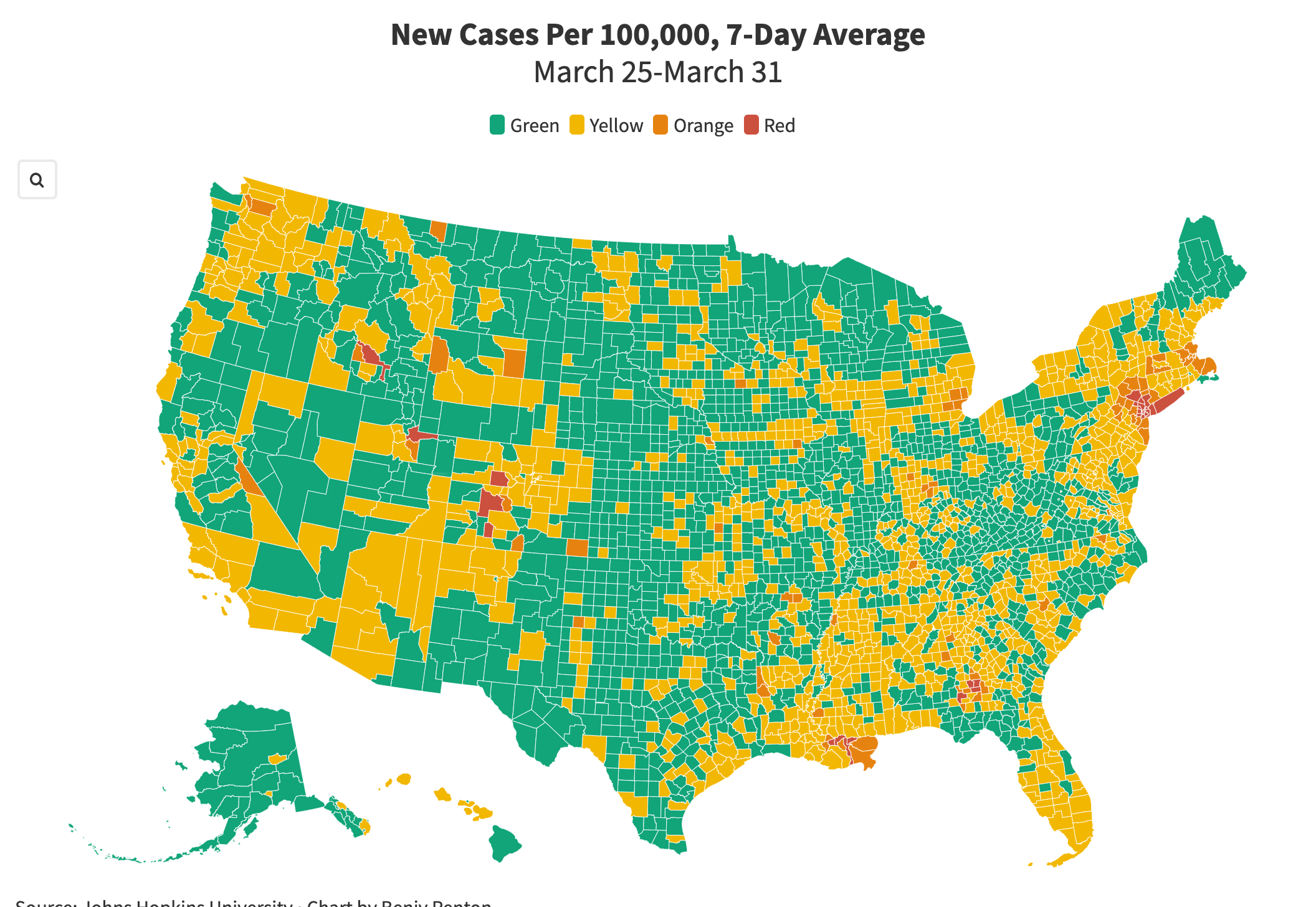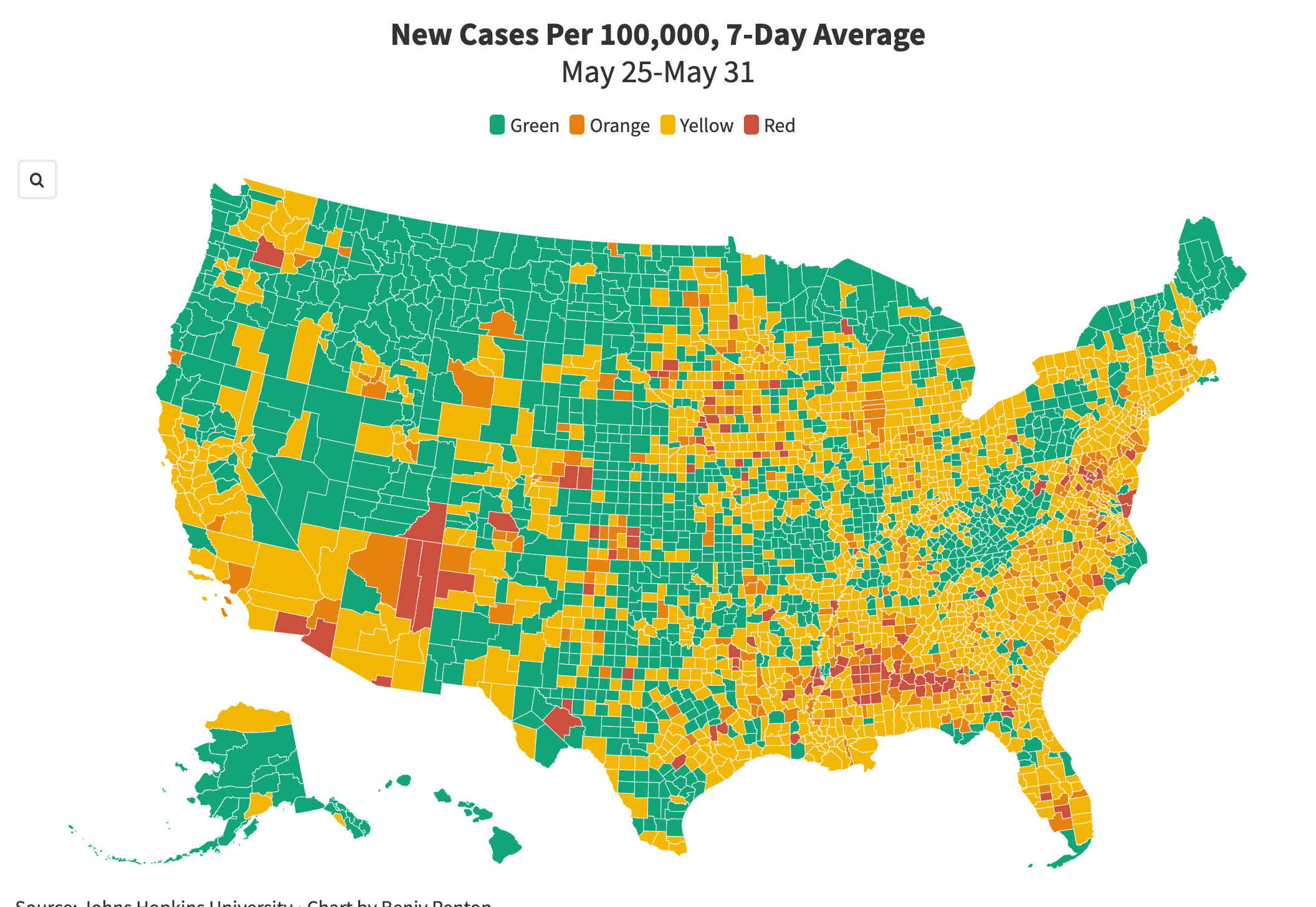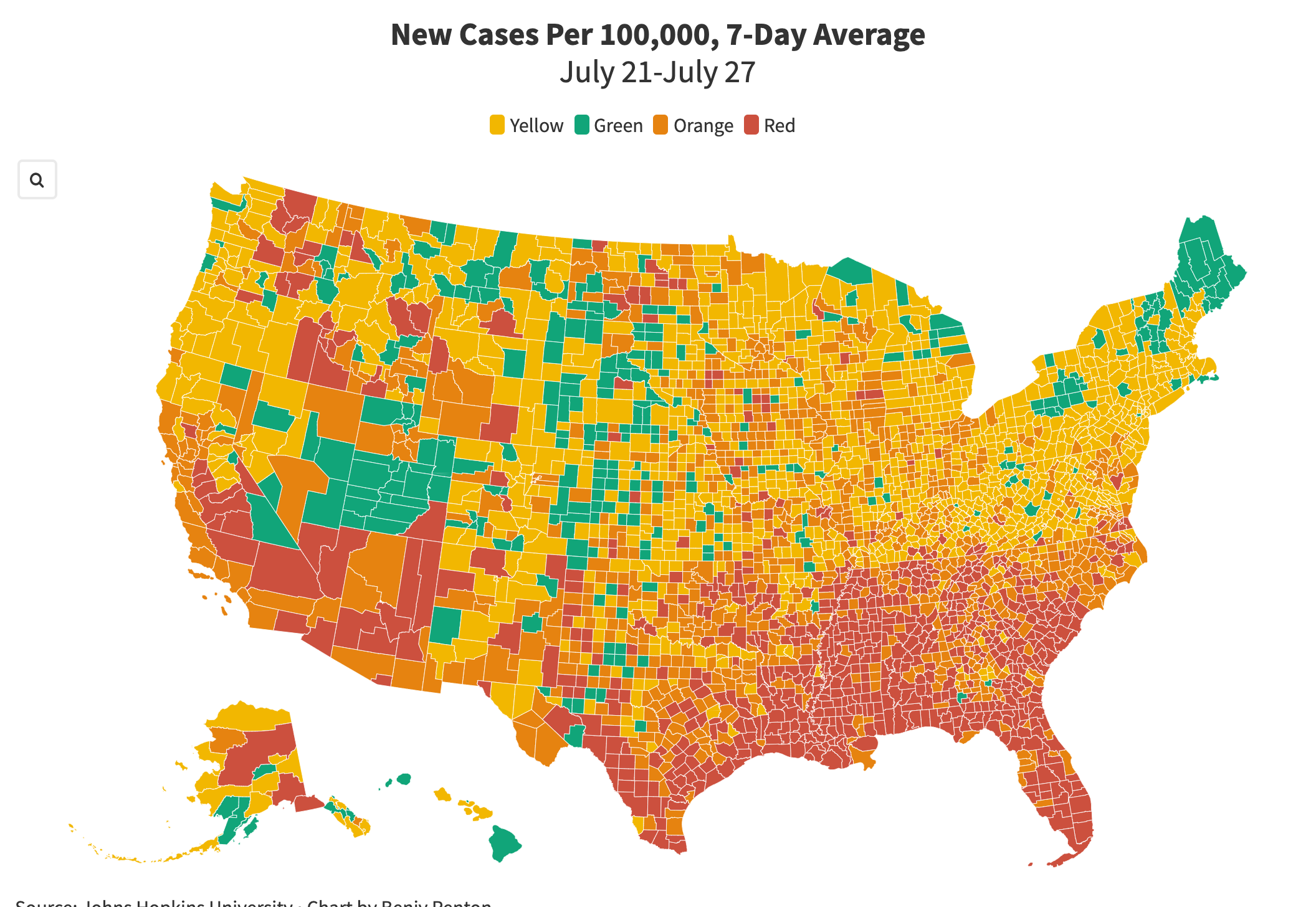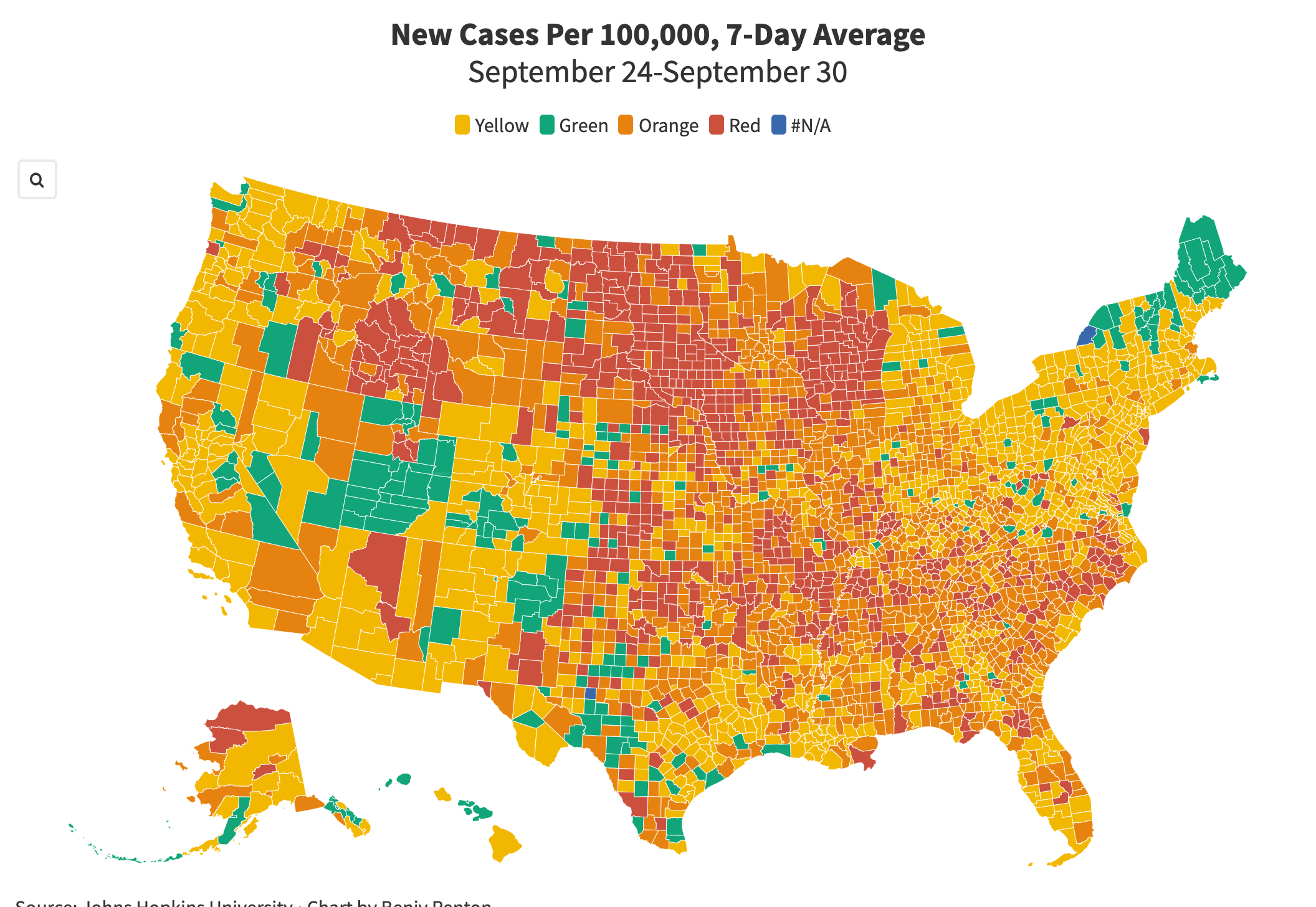Welcome back to Week 26 in my weekly reports analyzing the Covid-19 pandemic and its effects on the country and higher education. For those of you reading this on my blog, Off the Silk Road, I have also launched a newsletter, where these reports can be sent directly to your email each week. Click here to subscribe.
Last week, we took a break from our regularly scheduled programming to discuss my efforts tracking the outbreak in the White House. This week, we will attempt to make sense of troubling trends as we move into the fall and examine what colleges need to do to have a successful start to the spring. Each newsletter usually contains the week’s worth of information, however on this occasion we will include current and prior weeks’ analysis.
A national look
Much of the conversation over this long news week in America has focused on the country’s most well-known coronavirus patient: President Donald Trump. However, we cannot ignore the 57,000 new cases and over 900 new deaths on Friday alone.
It is good to hear that the president has shown early signs of recovery (based on what he and his doctors have divulged) from Covid-19. However, we must acknowledge that the vast majority of Americans cannot just “check in” to a hospital and receive the therapies that President Trump was administered. Do you know what is better than a therapeutic? Not contracting the disease in the first place. As temperatures drop and transmissions will increase indoors, we must remain vigilant to a virus that has killed over 213,000 Americans.
This week we are going to discuss two values that are crucial to our understanding of the pandemic but not frequently reported in your everyday news consumption: K and CT.
A K value can describe the dynamics of transmission as it relates to the number of people. The smaller the K value is, the more transmission comes from a smaller number of infectious people. For Covid-19, the K value is between 0.1 and 0.5. This means that without public health measures, only about 10-20% of infections generate about 80% of the transmission. Why is this important? Superspreading events. In order to live sustainably for the next year, we must focus on large gatherings as the predominate drivers of transmission and limit the chance of superspreading events from occurring. Let’s take a look at now one of the most well-known superspreading events in the last week: The White House. In just over a week, we have tracked over 329 individuals involved in the White House outbreak, spanning multiple events across the county. Teaming up with colleagues Peter Walker and Dr. Jesse O’Shea, we have created this tracking dashboard and recorded 38 positives from the outbreak so far of individuals ranging from journalists to White House residence staff. This virus spares no one, and President Trump’s reckless actions have put countless lives at risk. You can view our tracker here and explore various visualizations. We update the data between two and three times per day.
Since we have launched the tracker, I have appeared on Democracy Now and Vermont’s NBC5, in addition to being profiled in Seven Days. The dashboard has garnered over 700,000 views and has been featured in Forbes and New York Magazine.
The second value that is important to measuring infectiousness is CT — or cycle threshold. According to Science Magazine, “Standard tests identify SARS-CoV-2 infections by isolating and amplifying viral RNA using a procedure known as the polymerase chain reaction (PCR), which relies on multiple cycles of amplification to produce a detectable amount of RNA. The CT value is the number of cycles necessary to spot the virus; PCR machines stop running at that point.” Essentially, the lower the cycles are to detect the virus, the more virus present in an individual’s body. This would also make them more infectious, as they would be actively shedding more virus. Epidemiologists including Harvard’s Dr. Michael Mina argue that reporting this number with test results could help determine at what stage of infection an individual is and how contagious they may be. “We have to stop thinking of people as positive or negative, and ask how positive?” Mina says. While it is not a panacea for testing, CT values are incredibly useful to determine where an outbreak is spreading.
CT values also relate to having a multipurpose mindset for testing, which the U.S. has still failed to adopt. PCR tests should be used for clinical diagnoses; other forms of testing — antigen and CRISPR — can be used in surveillance and screening. “We believe that surveillance testing regimens that can sever enough transmission chains to reduce community spread should complement, not replace, our current clinical diagnostic tests,” Dr. Mina and Dr. Daniel Larremore write in The New England Journal of Medicine. “Imaginative strategies can take advantage of both kinds of tests, using frequent, cheap, and rapid tests at scale to mitigate outbreaks, with positive results confirmed using a second rapid test targeting a different protein, or using a benchmark PCR test.” These new testing technologies are being developed and it is likely that some will be on the market soon; the FDA needs to set up a pathway for new rapid tests to be evaluated.
While our attention has turned to the White House over the past week, we must continue to examine worsening trends nationwide. Cases have increased towards August levels and case counts are decreasing in just a small handful of states. Even areas like the Northeast, which has seen continued success in keeping the virus at bay, has seen upticks in test positivity. This “third wave” has already arrived.
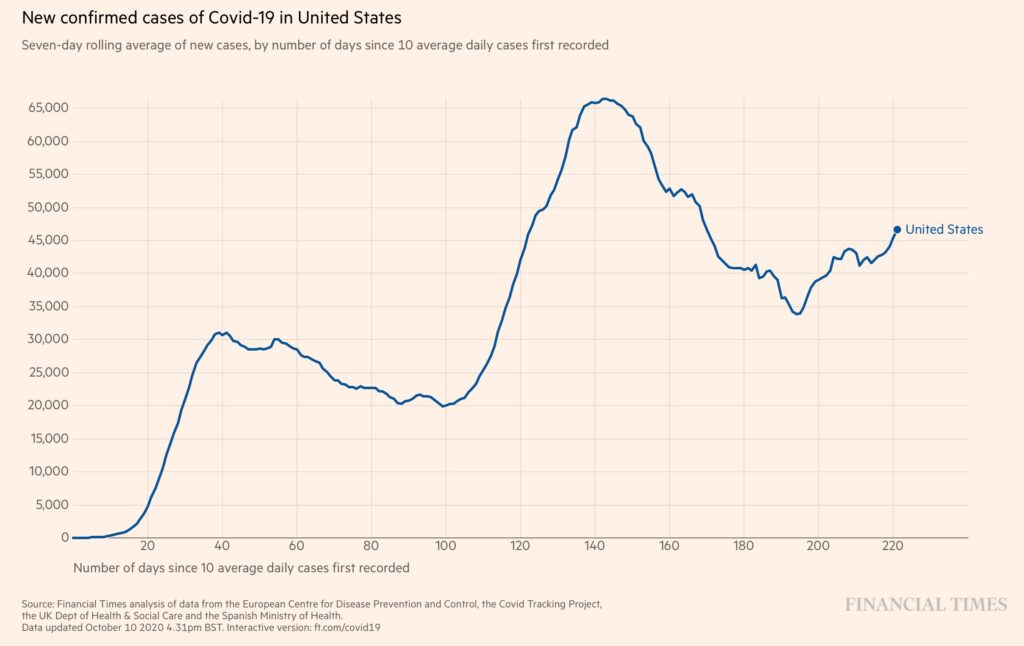
Let’s take a look at some of the latest scientific developments:
- An analysis conducted by researchers at Cornell University found that media mentions of President Trump within the context of Covid-19 misinformation made up by far the largest share of the infodemic. Trump mentions comprised 37.9% of the overall misinformation conversation, well ahead of any other topics.
- A new analysis published in JAMA Pediatrics found that children and adolescents younger than 20 years had 44% lower odds of contracting SARS-CoV-2 infection compared with adults 20 years and older; finding was most marked in those younger than 10 to 14 years.
- A CDC report found that Covid-19 incidence among adolescents aged 12–17 years was approximately twice that in children aged 5–11 years.
- Another CDC report on shifting age dynamics of the pandemic in late summer found that during August 2–September 5, 2020, weekly Covid-19 cases among persons aged 18–22 years increased 55% nationally. Increases were greatest in the Northeast (144%) and Midwest (123%). Increases in cases were not solely attributable to increased testing.
- Here’s an interesting one: Nielsen, a global marketing research firm reported a 54% increase in national (in-store and online) sales of alcohol for the week ending March 21, 2020, compared with 1 year before; online sales specifically increased 262% from 2019.
- Republicans who rely on Fox News and/or talk radio overwhelmingly believe that the U.S. could not have controlled the coronavirus outbreak any better, according to a new Pew Research poll.

- Results from the outbreak on the Theodore Roosevelt aircraft carrier this past spring were published in JAMA Network. The outbreak had an attack rate of 18%. 19.8% of sailors were completely asymptomatic, underscoring the importance of testing.
- The CDC published a report on the UNC outbreak in August, which saw 670 cases in 22 days without the use of initial testing or quarantine.
- A 13-year-old girl spread Covid-19 to 11 other people, despite receiving a negative rapid test, according to a CDC report, highlighting the importance of testing and other nonpharmaceutical interventions.
- A New York Times analysis shows the difference between Trump and Joe Biden’s stances on masks. “Although [Trump] says he is for masks, he frequently mocks them as wimpy accouterments of politically correct virtue signalers, and he often suggests that they pose many serious, though vague, dangers,” columnist Farhad Manjoo writes.
- It is possible for states to control epidemics, as seen in a new CDC report on Arizona. The number of Covid-19 cases in Arizona stabilized and then decreased after sustained implementation and enforcement of statewide and locally enhanced mitigation measures. This was clearly the result of mask mandates and enhanced sanitation practices.
- A study published in the Annals of Clinical and Translational Neurology found that nearly one-third of hospitalized Covid-19 patients experienced some type of altered mental function — ranging from confusion to delirium to unresponsiveness.
- On therapeutics, a new study shows that there may not be a statistically significant reduction of mortality rate in patients who take Remdesivir, but it does shorten recovery time. And no, again, hydroxychloroquine has no benefit as treatment for Covid-19.
- A new CDC report shows the change in Americans’ hand washing behaviors. As seen in these charts, hand washing in various situations has increased since the pandemic began, but men and white adults were usually less likely to wash hands.
Finally, some updates on vaccines.
- Dr. Moncef Slaoui, the head of Operation Warp Speed, told Marketwatch that the first vaccine should be submitted for emergency authorization around Thanksgiving and he is hopeful that the first vaccines will be 80-90% effective (I suppose this means that the president will not get his election gift).
- The FDA proposed stricter guidelines for emergency approval of a coronavirus vaccine, but the White House chief of staff objected to provisions that would push approval past Election Day, according to a report in The New York Times.
- The FDA has publicly released its set of guidelines it will use to determine the safety and effectiveness of vaccines to be approved.
- In his conversations with major drug-makers working on coronavirus vaccines, Trump has been explicit in telling the companies’ CEOs that he’d like to see a vaccine move quicker than some of his health advisers say is reasonable, according to a person familiar with the conversations and reported in CNN.
For those of you who thought that Trump would do an “about face” after his Covid-19 diagnosis, think again. We still do not know when his last negative test was, potentially exposing the fact that the White House testing strategy failed and he possibly exposed Joe Biden at the first presidential debate. Former CDC director Dr. Tom Frieden shared this useful graphic of an effective virus prevention strategy. Think of it as Swiss cheese.

At the end of July, Dr. Peter Hotez at the Baylor College of Tropical Medicine wrote a national plan detailing the steps we as a nation must take to safely reopen our schools, colleges, and businesses, and even have football back safely by October 1. Have we met these goals? From the end of July (when the report was written) to the end of September, daily cases are down 35%, hospitalizations down 49% and deaths down 29%. One would be quick to declare victory, but this is not the complete picture. However, when we look at the end of September’s numbers compared to the beginning of the month, we see significantly worse outcomes — an 8% increase in cases, 11% decrease in hospitalizations and 12% decrease in deaths. These two maps show the changes in testing and cases from July to September and throughout the month of September. States in green show testing increasing with cases decreasing, indicating that more testing has been able to diminish the size of outbreaks. (Mr. President, more testing does not always lead to more cases.) States in red show testing decreasing with cases increasing. States in pink and orange may not have their arms wrapped around an outbreak, either due to a lack of testing or the virus itself spreading. As seen on these two maps, more and more states are conducting more tests but seeing more cases. This indicates that the pandemic is spreading faster than testing can keep up.
Now to containment. Some experts have defined containment as one new case per million per day. No state has currently met this, with Vermont being the closest as of yesterday (6.8 new cases per million). Some states are 500x off from the containment benchmark.
So maybe states are not the best unit of analysis. Let’s take a look at counties. A Harvard Global Health Institute report earlier in the summer used new cases per 100,000 as a metric for school reopenings. While the end of July had more counties in the “red zone,” a spike is currently underway in the Midwest.
In short, our efforts to contain the pandemic by October 1 have failed by epic proportions. Schools have reopened and then closed shortly thereafter due to rise in cases. There are reports of overwhelming hospitals in states such as Wisconsin and North Dakota. This new “wave” is starting in the northern Midwest and, if we are not careful, will begin to spread across our country once again. The IHME model at the University of Washington is predicting 363,269 deaths by December 1 and the CDC says there will be 21,000 new American deaths by October 31. This past week, Dr. Hotez has called for an “autumn reset.” “It is never too late to contain COVID-19 and with resolve and commitment, it is possible for the president to charge his task force with halting COVID-19 transmission, or to delegate this mission to the CDC,” he writes.
Let us take action on Dr. Hotez’s words and change our behavior to save lives. We know the tools that work; we are just not using them.
As the worldwide death toll has passed 1 million, Trump’s anti-science approach has caused both The New England Journal of Medicine to issue a presidential endorsement for Joe Biden, the first in its 208-year history. “Our current political leaders have demonstrated that they are dangerously incompetent,” they write. “We should not abet them and enable the deaths of thousands more Americans by allowing them to keep their jobs.” This week, we also learned that William Foege, a former CDC director, asked the current CDC leader last month to expose the failed U.S. response to the coronavirus, calling on him to orchestrate his own firing to protest White House interference. Additionally, The New York Times reported that the CDC drafted a sweeping order last month requiring all passengers and employees to wear masks on all forms of public and commercial transportation in the United States, but it was blocked by the White House, according to two federal health officials. This anti-science approach by this current administration will take decades to recover from.
Let’s move on to our discussion of higher education.
Higher education
Each Friday, I update the College Watchlist, which is currently tracking 98,965 total cases at 91 colleges. 4,958 (5.01%) of those were recorded in the last 7 days. The New York Times has also updated its count, showing 178,000 cases at over 1,400 colleges. At the top of my list of cases in the last 7 days are:
- Clemson University – 300
- Miami University-Oxford – 300
- Penn State – 287
- Appalachian State – 190
- Brigham Young University – 175
First, we mourn the devastating loss of 19-year-old Appalachian State University sophomore Chad Dorrill, who died on September 28 from Covid-19 complications. In a tribute to his life on CNN, anchor Jake Tapper said, “His classmates say that young people are not invincible to this deadly virus.” Every life lost is a tragedy, but the death of a student has shaken the community.
As we move further along into the fall and into the spring planning process, we will attempt to answer a few questions:
- What went well from the fall?
- What didn’t work from the fall?
- How can we keep colleges open even if the national picture is worsening?
Over the coming weeks, I will be working on analyses that will paint a more complete picture of the tools colleges must employ to have successful and safe semesters. Among them is Colby College in Maine, which tests all students twice per week. In addition, low community transmission and a willingness on the part of the students to abide by protocols have contributed to Colby’s success. Similarly, schools in Vermont have seen early successes with robust testing plans and state-mandated behavior pledges.
So what doesn’t work?
- Politics. New research from Chris Marsicano at Davidson College and a handful of other collaborators found that colleges in Republican-led states were more likely to reopen in-person, but county case rates appear to have limited influence on reopening.
- Voluntary testing. My colleague Sami Sparber at the Texas Tribune reports on some schools in Texas that do not require students to get tested regularly, but instead have opt-in surveillance programs and a surplus of tests. “Unless you’re going to have a routine program that you require the entire population to adhere to, I just don’t know what you’re doing,” Yale professor Dr. David Paltiel said.
- Inequities between athletes and the rest of the student body. 26% of the tests performed in the Thomas Jefferson Health District from September 21-27 were for UVA athletes, despite being an incredibly small part of the population. Testing equity is a huge issue — especially when some UVA students cannot get one.
- Lack of support for students’ mental health. In a new survey by Active Minds, 87% of students said they’d experienced stress or anxiety during the pandemic, 77% said they’d felt lonely or isolated. The Chronicle of Higher Education’s Sarah Brown dives into the specifics of how colleges can better support their students.
Let’s take a minute to discuss college testing. On September 30, the CDC updated its testing guidance for colleges and universities. Previously recommending testing for only symptomatic individuals and contacts (and not recommending entry testing), the agency posted more comprehensive guidelines. This new guidance was no doubt a result of a JAMA commentary, in which CDC Director Dr. Robert Redfield was a co-author. “Robust testing both on and near campuses will be essential for reducing or preventing transmission,” the authors write. The reasons for which testing might be performed were greatly expanded to include outbreak testing, screening and surveillance. First: Symptomatic individuals and asymptomatic contacts. The new guidance is more detailed. CDC now suggests testing for all those in an expanded setting (residence hall floor) as well as widespread testing (across buildings). CDC recommends full quarantine regardless of result. In the context of an outbreak, the CDC presents a tiered system for testing priority. After symptomatic individuals and contacts, those in outbreak settings come next, followed by a random sample of asymptomatic students, faculty, and staff. The CDC also addresses off-campus transmission: “Strategies to mitigate the spread of SARS-CoV-2 are not only to limit transmission on IHE campuses, but to also prevent transmission to the surrounding community.” These guidelines are a major step up from this past summer’s version, which will hopefully inform colleges for the spring.
In addition to the CDC’s new guidance, an analysis conducted by Davidson College’s College Crisis Initiative and published in NPR shows that more than 2 out of 3 colleges with in-person classes either have no clear testing plan or are testing only students who are at risk — mostly when they feel sick or have had contact with someone who has tested positive for the coronavirus. Even most colleges in hotspot counties do not have adequate testing plans.
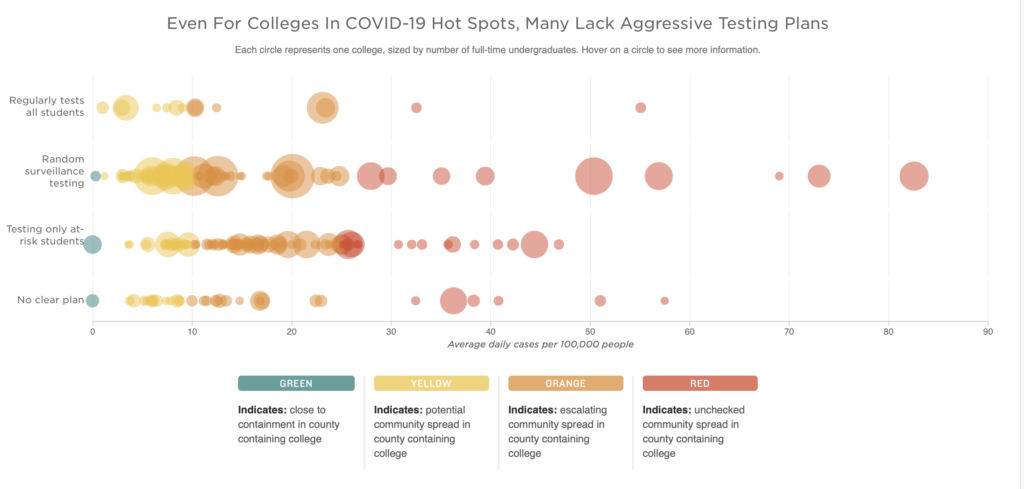
Each week, we take a moment to acknowledge the wacky, stupid and downright dumb elements of colleges’ reopening plans, also known as the College RidicuList.
- “Tiger King” star Carole Baskin made an appearance in a Princeton University video, urging students to refrain from large gatherings and observe public health protocols.
- At Indiana University, multiple students living in Greek houses that are supposed to be under quarantine have requested Uber rides to both leave and return to their houses. Similar incidents have also occurred at Arizona State University.
Here are some samples from op-eds and editorials in student newspapers this week, which are always useful for capturing perspectives from students, faculty, staff and local community members.
- “Jenkins leaving South Bend to flagrantly disobey his own rules while the community he is supposed to lead is suffering creates a sense of separation between himself and everyone else,” the editorial board of Notre Dame’s student newspaper writes as they criticize the university’s president who attended the White House superspreader event in the Rose Garden.
- “Both the university and students need to do better. If Chad’s death wasn’t enough of a wake-up call, what will be? Will it be when your roommate is too sick to get up? When you infect your grandparents with COVID-19 on a weekend visit?” editors at Appalachian State University write after the death of a fellow student.
- “The University is doing students a disservice by leaving them in the dark on so many areas of its COVID-19 response plan,” students at Louisiana State University write as they call for more transparency.
- “Partying: it’s what college kids do. Partying during a pandemic? That shouldn’t be what college kids do. It is irresponsible for our governor to condone partying while our state and country are under siege by a pandemic,” editors at the University of Florida write.
- “Some college students are part of the problem, but we won’t take the full blame for making it worse,” editors at Michigan State University write. “Let’s work together to slow the spread of the virus, without making anyone a scapegoat.”
- “We took the steps that are at the heart of any public health initiative to control infection: establishing robust programs for testing with rapid turnaround, contact tracing, and isolation and quarantine,” the president and provost of Cornell University write.
- “With lives on the line, the stakes are far too high for the University and its community members to take any unnecessary risk. It’s time for practices to be updated,” editors at Brown University write as they call for clearer guidelines from the university.
- The student newspaper at the Claremont Colleges published a series of answers to the following question: “If you could tell your professors anything about this semester, what would you say?” “[I] can’t do anything that makes me happy,” one student said.
We continue to watch outbreaks in states with high case counts, including Idaho. “Test positivity in 18-24 year-olds is 80.7% in Latah County (University of Idaho), 22.9% in Madison County (Brigham Young University-Idaho), 15.6% in Ada County (Boise State University) and 10.3% in Bannock County (Idaho State University),” according to local reports.
So what will work for the spring? In a piece in Time Magazine, physicians Dr. Gavin Yamey and Dr. Nahid Bhadelia opine on keys to success:
- Drive down community transmission
- Test all students on entry and conduct surveillance testing frequently
- Have robust quarantine and isolation facilities
- Offer safe opportunities for socializing
- Adopt a multitude of nonpharmaceutical interventions
- Strive for transparency in reporting case counts
We must continue to use what we’ve learned in the fall and apply it to the spring.
Study abroad and international travel
We will continue to monitor abroad program suspensions for the spring, the latest being Brown University.
The Good Stuff
Let’s roll the clips of the good stuff. In my usual tradition, I feature my favorite stories from the week. Here are my Top 16.
- A 102-year-old woman in Chicago who never missed a vote casts her mail-in ballot in full PPE.
- Japanese viewers of the first presidential debate heard three interpreters attempting to make sense of the fracas between Trump and Biden.
- The National Zoo panda cub received its first vet checkup.
- A Bowdoin College student serves as a contact tracer for the Maine CDC.
- The New Yorker published a compelling photo essay on the first day of in-person school for some New York City students.
- Representative Katie Porter has made her way into popular culture with the whiteboard she uses at Congressional hearings.
- One student at Arizona State University documented her experiences through a 14-day quarantine.
- As many seniors find themselves cut off from loved ones during the pandemic, some are turning to automated animals for company.
- The star at the vice presidential debate was neither of the candidates, but a fly on Mike Pence’s head.
- Seven months after the pandemic began, Clorox wipes are still hard to come by.
- Teachers share their experiences as school returns during the pandemic in a Washington Post article.
- After days of battling other corpulent contenders, 747 was crowned 2020’s Fat Bear Week champion, beating 32 “Chunk” in the finals on Fat Bear Tuesday.
- The Wall Street Journal’s Maya Goldman takes us on virtual field trips at schools across the country.
- Feed the Polls is organizing thousands of meals for 2020 voters in food-insecure areas, as reported by CNN’s Allison Gordon.
- According to an Irish court, Subway’s bread is too sugary to be classified as such.
- The Brown Daily Herald’s Olivia George shows us what campus looked like during the 1918 flu pandemic.
Conclusion
As the U.S. continues its fight against the pandemic, we must wrestle with the dark reality that state by state, the virus is winning. Cases, hospitalizations, test positive and deaths are all trending in the wrong direction. The president has turned his focus on aspects unrelated to the pandemic response (but when has he ever focused on the pandemic anyway?) and it is up to all of us to keep each other safe. And that includes voting.
I’d like to thank all the student journalists with whom I have the pleasure of working. In the next weeks and months ahead, they will become vital in chronicling their colleges’ paths forward for the fall and beyond. Support their work by reading it.
My best to all for good health.
Like what you see? Don’t like what you see? Want to see more of something? Want to see less of something? Let me know in the comments. And don’t forget to subscribe to the weekly newsletter!
For more instant updates, follow me on Twitter @bhrenton.

